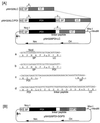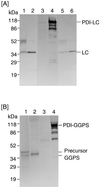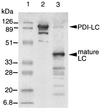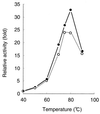A protein disulfide isomerase gene fusion expression system that increases the extracellular productivity of Bacillus brevis
- PMID: 10653729
- PMCID: PMC91874
- DOI: 10.1128/AEM.66.2.638-642.2000
A protein disulfide isomerase gene fusion expression system that increases the extracellular productivity of Bacillus brevis
Abstract
We have developed a versatile Bacillus brevis expression and secretion system based on the use of fungal protein disulfide isomerase (PDI) as a gene fusion partner. Fusion with PDI increased the extracellular production of heterologous proteins (light chain of immunoglobulin G, 8-fold; geranylgeranyl pyrophosphate synthase, 12-fold). Linkage to PDI prevented the aggregation of the secreted proteins, resulting in high-level accumulation of fusion proteins in soluble and biologically active forms. We also show that the disulfide isomerase activity of PDI in a fusion protein is responsible for the suppression of the aggregation of the protein with intradisulfide, whereas aggregation of the protein without intradisulfide was prevented even when the protein was fused to a mutant PDI whose two active sites were disrupted, suggesting that another PDI function, such as chaperone-like activity, synergistically prevented the aggregation of heterologous proteins in the PDI fusion expression system.
Figures





Similar articles
-
Production of human protein disulfide isomerase by Bacillus brevis.J Biotechnol. 1994 Mar 15;33(1):55-62. doi: 10.1016/0168-1656(94)90098-1. J Biotechnol. 1994. PMID: 7764724
-
Protein disulfide isomerase does not control recombinant IgG4 productivity in mammalian cell lines.Biotechnol Bioeng. 2010 Mar 1;105(4):770-9. doi: 10.1002/bit.22587. Biotechnol Bioeng. 2010. PMID: 19882737
-
Increase of soluble expression in Escherichia coli cytoplasm by a protein disulfide isomerase gene fusion system.Protein Expr Purif. 2005 Dec;44(2):155-61. doi: 10.1016/j.pep.2005.03.030. Epub 2005 Apr 19. Protein Expr Purif. 2005. PMID: 15882951
-
Isomerase and chaperone activities of protein disulfide isomerase are both required for its function as a foldase.Biochemistry (Mosc). 1998 Apr;63(4):407-12. Biochemistry (Mosc). 1998. PMID: 9556523 Review.
-
Protein disulfide isomerase assists protein folding as both an isomerase and a chaperone.Ann N Y Acad Sci. 1998 Dec 13;864:9-13. doi: 10.1111/j.1749-6632.1998.tb10283.x. Ann N Y Acad Sci. 1998. PMID: 9928079 Review.
Cited by
-
Strategies for successful recombinant expression of disulfide bond-dependent proteins in Escherichia coli.Microb Cell Fact. 2009 May 14;8:26. doi: 10.1186/1475-2859-8-26. Microb Cell Fact. 2009. PMID: 19442264 Free PMC article.
-
How to achieve high-level expression of microbial enzymes: strategies and perspectives.Bioengineered. 2013 Jul-Aug;4(4):212-23. doi: 10.4161/bioe.24761. Epub 2013 Apr 25. Bioengineered. 2013. PMID: 23686280 Free PMC article. Review.
-
Oxidative Folding of Conopeptides Modified by Conus Protein Disulfide Isomerase.Protein J. 2017 Oct;36(5):407-416. doi: 10.1007/s10930-017-9738-6. Protein J. 2017. PMID: 28856545
-
Bacterial cell factories for recombinant protein production; expanding the catalogue.Microb Cell Fact. 2013 Nov 18;12:113. doi: 10.1186/1475-2859-12-113. Microb Cell Fact. 2013. PMID: 24245806 Free PMC article. No abstract available.
-
A Conceptual Framework for Integrating Cellular Protein Folding, Misfolding and Aggregation.Life (Basel). 2021 Jun 24;11(7):605. doi: 10.3390/life11070605. Life (Basel). 2021. PMID: 34202456 Free PMC article. Review.
References
-
- Burnette W N. “Western blotting”: electrophoretic transfer of proteins from sodium dodecyl sulfate-polyacrylamide gels to unmodified nitrocellulose, and radiographic detection with antibodies and radioiodinated protein A. Anal Biochem. 1981;112:195–203. - PubMed
-
- Gilbert H F. Protein disulfide isomerase and assisted protein folding. J Biol Chem. 1999;272:29399–29402. - PubMed
-
- Hayano T, Hirose M, Kikuchi M. Protein disulfide isomerase mutant lacking isomerase activity accelerates protein folding in the cell. FEBS Lett. 1995;377:505–511. - PubMed
-
- Hillson D A, Lambert N, Freedman R B. Formation and isomerization of disulfide bonds in proteins: protein disulfide-isomerase. Methods Enzymol. 1984;107:281–294. - PubMed
MeSH terms
Substances
LinkOut - more resources
Full Text Sources
Other Literature Sources

